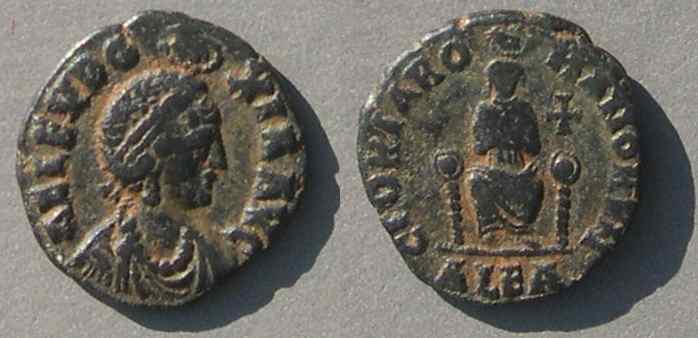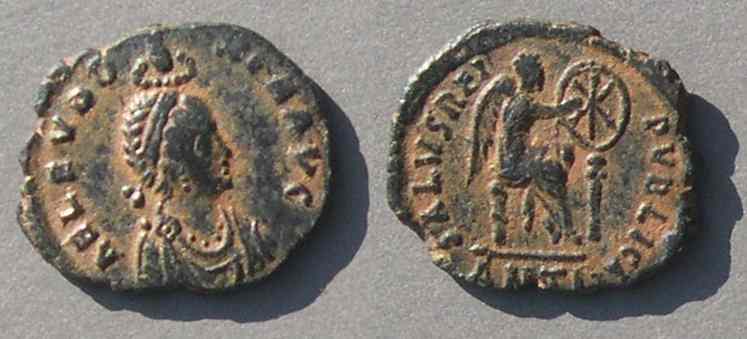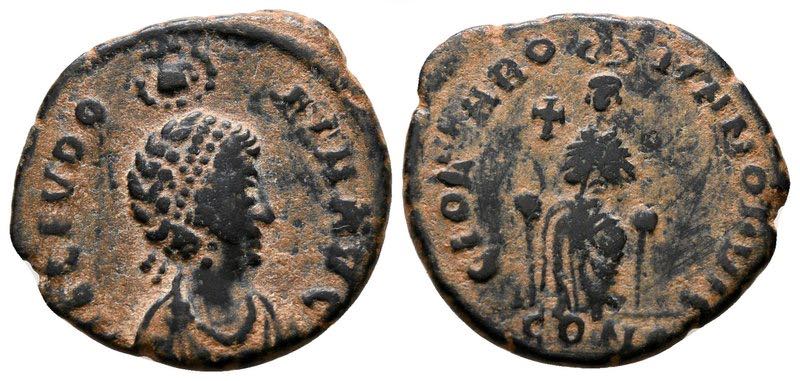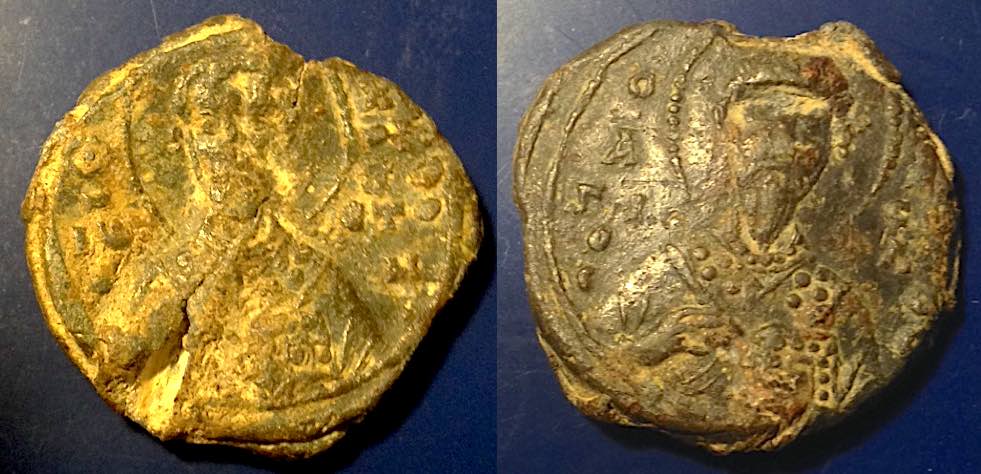Eudoxia, wife of Roman Emperor Arcadius. Augusta 400-404. Her two AE coin types.
History. Eudoxia was the daughter of a Roman mother and Bauto the Frank, who had been a prominent general under Valentinian II. At the end of the fourth century many "barbarians" were generals in the Roman army and others were important at court. Theodosius, father of Arcadius and Honorius, had been an active and able military man, but he died in 395 and his sons were both weak and ineffectual. Although Arcadius was 17 in 395 and had been Augustus in the East since he was 5 years old in 383, real power was wielded by a succession of advisors who were Goths or eunuchs. The ambitious Praetorian Prefect Rufinus expected Arcadius to marry his daughter, but in 395 while Rufinus was on a trip, the Lord Chamberlian, the eunuch Eutropius, outwitted Rufinus by introducing Arcadius to the outstandingly beautiful Eudoxia and arranging a hasty marriage. She was awarded the title Augusta in 400 and bore Arcadius at least five children, including the future emperor Theodosius II in 401. She died from a miscarriage in 404. In spite of being pregnant most of the time, by 400 she had taken the reigns of imperial power from her weak husband. She was extremely involved in Church affairs in an age when church disputes could make or break rulers. Her coins exhibit her piety; she is crowned by the Hand of God.
AE Types. Eudoxia appears on two types, both AE3's, SALVS REIPVBLICAE and GLORIA ROMANORVM.
SALVS REIPVBLICAE. This SALVS type is the earlier of the two according to Grierson (but not RIC) and may refer to her success in providing the empire with an heir, which was expressed on coins as affirming the well-being (SALVS) of the republic.
 18 mm. 2.14 grams.
18 mm. 2.14 grams.
AEL EVDOXIA AVG
Bust right draped and with pearl-diadem. Hand of God crowning her.
(The obverse is the same on all her coins.)
Eudoxia was not from the Aelia family. After Aelia Flacilla, wife of Theodosius, AELIA had become a title.
SALVS REIPVBLICAE
Victory seated on a cuirass, inscribing a cross on a shield
[RIC has only a cuirass, but this example has more than just that, I think including a shield and quiver or parazonium.]
In exergue: SMKA for Sacra Moneta Cyzicus, officina A.
RIC X Arcadius 104, page 249 variety (with cross for chi-rho) from Cyzicus. Sear V 2084. DOC 284. Struck 401-2 [RIC] or 400 [Grierson in DOC].
The dating of her types is uncertain. We know the only male heir to survive was Theodosius II, born in 401. If the type really celebrates a male child, it should be after his birth. In those days the role of a wife was supposed to be to provide an heir. On the other hand, Eudoxia was remarkably capable and influential and she became Augusta on January 9, 400, even before having a male child (unless she had an earlier unrecorded male child who died in infancy which is quite possible). That occasion may have prompted an issue of coins in her name.
Aelia Flaccilla, wife of Theodosius, was the first Augusta since Constantine's wife Fausta and mother Helena. In a break with tradition, her coins were the first to display insignia--diadem, paludamentum, and fibula--that identified an Augustus. Eudoxia is also portrayed as Augusta with those insignia, which is an indication of her power.
GLORIA ROMANORVM. The second type has legend GLORIA ROMANORVM and has the Hand of God on both sides. Here is an example minted at Alexandria.
 17 mm. 2.28 grams.
17 mm. 2.28 grams.
Obverse as on all her coins:
AEL EVDOXIA AVG
Bust right draped and with pearl-diadem. Hand of God crowning her.
Eudoxia was not from the Aelia family. It seems that since Aelia Flaccilla, wife of Theodosius, AELIA had become almost a title.
GLORIA ROMANORVM, empress enthroned facing with arms crossed before her breast, being crowned by the Hand of God.
Cross in right field.
ALEA for Alexandria, officina number A.
RIC X Arcadius 84, page 248 "400-401." Sear V 20891. DOC 294. Struck 403-404.
The SALVS type was minted at four mints (see the table below). The next example, from Antioch, varies in reverse details from the first example.
 18-16 mm. 2.32 grams.
18-16 mm. 2.32 grams.
AEL EVDOXIA AVG
Bust right draped and with pearl-diadem. Hand of God crowning her.
SALVS REIPVBLICAE
Victory seated, inscribing a chi-rho(?) on a shield supported by a column
in exergue: ANTΓ [If there is a loop of a rho (P), it is very small.]
RIC X Arcadius 104, "401-403." Sear V 20895. DOC 287 "No loop to Christogram on shield, thus making it a simple monogram of IX." "400-401"
It seems obvious the symbol should be a chi-rho, but very few examples have a clear loop and those that do have a loop to the left--the wrong way.
Here is a GLORIA ROMANORVM coin minted at Constantinople.
 18-16 mm. 2.50 grams.
18-16 mm. 2.50 grams.
AEL EVDOXIA AVG
Bust right draped and with pearl-diadem. Hand of God crowning her.
GLORIA ROMANORVM, empress enthroned facing with arms crossed before her breast, being crowned by the Hand of God.
Cross in left field.
CONB for Constantinople, with an uncertain officina number, perhaps B (Γ is the other possibility listed in RIC).
RIC X Arcadius 78, page 247. Struck 401-2. Sear V 20877. DOC 291 "403-404"
There were also gold solidi and rare tremisses issued in her name. There is a unique semissis and extremely rare silver pieces. The AE3 types above are scarce or rare, but not many collectors emphasize late Roman AE from the fifth century, so they are not expensive. Eudoxia is ranked number 132 on Rasiel Suarez's revised list of frequencies on Roman imperial coins.
The Hand of God. There is another reason that coins show the Hand of God. Previously the emperor was the source of power because he lead the army. In the late fourth century power began to shift toward those who could be portrayed as in the favour of God, such as Church leaders and pious rulers. For example, at the Battle of the Frigidus (5-6 September 394) against the forces of Eugenius, a high wind came up that helped the Christian forces of Theodosius win. Some interpreted it as an intervention by God. It become more important to emphasize being in the favor of God, which the Hand of God type does. It had been used before on coins of her husband Arcadius.

Arcadius, 383-408.
20 mm. 4.52 grams.
Struck 383-388
Prominent Hand of God crowning small bust of Arcadius right, with spear and shield
GLORIA ROMANORVM
Emperor standing front, head left, holding labarum and resting left on shield, captive at his feet to the left.
CONΓ✳ in exergue.
RIC Constantinople 53a.
St. John Chrysostom. Eudoxia was very beautiful and pious. However, she was vain and not charitable, sins emphasized in the preaching of John Chrysostom "Golden-Mouthed," the archbishop of Constantinople beginning in 398. (The term "Patriarch" of Constantinople did not come into use until created at a synod of 451.) He later became Saint John. His continued criticism of the ruling classes for extravagance and arrogance, as well as his preaching (indirectly aimed at Eudoxia) that women were like Eve and should remain subservient, resulted in Eudoxia's wrath. His ongoing dispute with the Bishop of Alexandria gave excuse for a synod in Autumn 403 at which John was deposed and exiled. There were popular riots in favor of John. When her young daughter Flaccilla died, or maybe because of frightful earthquake (accounts differ), Eudoxia repented and had him recalled, but not for long. He resumed his preaching against women and before Eudoxia died from a fatal miscarriage on Oct. 6, 404, she managed to have him exiled again in April 404, this time to a distant and empty place in Pontus or maybe Roman Armenia, where he died in 407. Wikipedia does not mention his conflict with Eudoxia as contributing to his exile, but Holum regards it as central and Norwich notes their enmity.
John was later made a saint and his image used on some Byzantine seals. Here is one from about the 12th century in the collection of my friend Gary Waddingham and used with his permission:
 St John Chrysostom
St John Chrysostom
To left: O for "O Hagios" or "Saint"
I ω to left with bar above, abbreviating "John".
To right: X/PU/CO/CTO/M/I
St. Basil
To left: O AΓIOC to left. To right: letters including C, I, and Λ,
St. Basil, along with Gregory of Nyssa (Basil’s brother) a.k.a. Gregory The Theologican, and John Chrysostum were the three great hierarchs of the Eastern Church.
Mints and rarities in RIC for the GLORIA ROMANORVM type:
| mint |
RIC |
Eudoxia |
RIC plate |
| Con |
77-79 |
2,S,S |
4.77-79 |
| Nic |
80 |
S |
4.80 |
| Cyz |
81 |
S |
4.81 |
| Ant |
82-83 |
5,S |
4.82-83 |
| Ale |
84 |
S |
4.84 |
RIC X pages 70, 247-248.
Not struck at Heraclea. The cross is in the left field only at Constantinople.
Mints and rarities in RIC for the SALVS REIPVBLICAE type:
| mint |
RIC |
Eudoxia |
Pulcheria |
plate |
| Con |
101,420 |
S |
4 |
5.101, Pu-- |
| Nic |
102 |
R |
|
5.102 |
| Cyz |
103 |
S |
|
5.103 |
| Ant |
104-5 |
S, R3 |
|
5.104-5 |
Not struck at Heraclea.
Shield variously inscribed with chi-rho (Antioch), chi-iota (Antioch), or cross (Cyzicus, above).
RIC X, p. 249 for Eudoxia and p. 273 for Pulcheria, which has a footnote suggesting at least one of these is tooled from Flaccilla and none are confirmed. This type is, in my opinion, not issued for Pulcheria.
Antioch 105 for Eudoxia omits the hand of God on the obverse.
Sources and History. If you like coins of this time period, I recommend the reference works I cite. The Holum and Norwich history books are lots of fun. It is interesting that wikipedia, Holum, Norwich, and other sources have many points of disagreement which made it difficult to find a single story line that all could agree was "true." For example, Eudoxia managed to get the archbishop of Constantinople exiled and I found four different places mentioned as the place of exile. And that would be a fact and presumably not controversial. In contrast, motivations for behavior, which cannot be known in the same way facts can, are also given with great differences by different historians, ancient and modern.
I think I detect a contribution of the time in which the historian was writing. The more recent modern historians seem to think she was a strong woman unfairly treated in those misogynistic times. Historians from long ago seem to think she was an evil woman who got power with her great beauty and willingness to use sex.
So, in looking at many sources to try to write this web page, I saw lack of reliable evidence replaced by best-guesses and even "spin." I think we need to realize that history has always been "spun," ancient sources used spin as much as modern sources, and there is no certain way to know what really happened 1600 years ago. Even the coins yield controversies. There are only two AE types and Grierson and Kent do not even agree on which was issued first! That makes dates for them different in their two books.
Conclusion. Eudoxia was a powerful woman in an age when women were not supposed to be powerful. She minted only two AE types, each of which emphasizes her piety with a "Hand of God" crowning her.
References:
[RIC] Roman Imperial Coinage, Volume 10, by J. P. C. Kent. 1994.
Theodosian Empresses, by Kenneth Holum. 1982.
Byzantium: The Early Centuries, by John Julius Norwich. 1989.
[Sear V] Roman Coins and Their Values, Volume V, by David Sear. 2014.
[DOC] Catalogue of Late Roman Coins in the Dumbarton Oaks Collection and in the Whittemore Collection, by Philip Grierson and Melinda Mays. 1992.
Go to the Table of Contents for all the educational pages.
Go to the main page on late Roman bronzes.
 18 mm. 2.14 grams.
18 mm. 2.14 grams. 17 mm. 2.28 grams.
17 mm. 2.28 grams. 18-16 mm. 2.32 grams.
18-16 mm. 2.32 grams. 18-16 mm. 2.50 grams.
18-16 mm. 2.50 grams.
 St John Chrysostom
St John Chrysostom